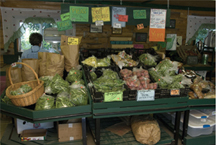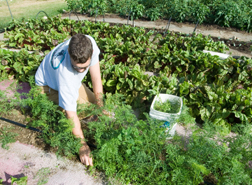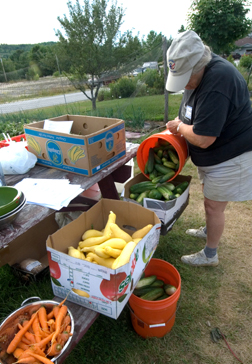Maine Home Garden News — June, 2010
- June is the month to . . .
- There’s More To Weeding Than Meets the Eye! Cultural Weed Control
- Gardening for Others
June is the month to . . .
By Rick Kersbergen, Extension Educator, Waldo County, richardk@umext.maine.edu
- Visit a strawberry farm to “pick your own.” Picking fresh and freezing for the winter is a great way to buy local all winter long.
 Visit farmers markets to purchase foods and support your local growers.
Visit farmers markets to purchase foods and support your local growers.- Make succession plantings of crops like beans to maintain your harvest of fresh vegetables throughout the summer. Plant small amounts to keep harvesting enough for fresh meals throughout the summer.
- Contact food pantries and soup kitchens to learn how and when they can use extra produce from your garden for their clients. Food donations are very welcome, but times and locations may be limited for when donations can be effectively used. It is better to know when someone can use the product ahead of time.
- Stake and prune your tomato plants. Staking and pruning will improve the quality of the plants and the fruit you are trying to grow. Pruning suckers can help improve air flow and slow the development of foliage diseases, especially for indeterminate-type tomatoes. It is good practice to clean and sanitize your tomato stakes to prevent diseases. Visit the Cornell Tomato Growing Guide for more information.
- Stay ahead of weeds in your garden. Small weeds are much easier to control than large ones! Small weeds can easily be pulled or hoed and left to dry on the soil surface. Larger weeds and some problem weeds like gallisoga can easily “re-root” themselves if pulled and left on the soil surface. Make sure you keep weeds from going to seed to prevent problems next year!
- Use organic mulches to control weeds and maintain soil moisture. Straw is excellent mulch if you can find it. Hay will work, but may have weeds seeds that can cause problems later in the garden season or next year. Consider using four layers of newspaper as a mulch and anchor it down with soil, stones, or pins.
- Regularly check your plants for insects and diseases. Watch UMaine Extension reports to see if late blight might be in your area and prepare for protective measures. Become a friend of UMaine Cooperative Extension on Facebook for updates and pest reports!
- Pick a garden problem to solve. Identify it. List possible strategies. Try least toxic approach.
- It’s not too late to start a garden. Consider beginning or expanding a garden space. Call 1-800-287-1471 to obtain a vegetable planting chart.
There’s More To Weeding Than Meets the Eye! Cultural Weed Control
By Mark Hutchinson, Extension Educator, Knox-Lincoln Counties, markh@umext.maine.edu
 In the last couple of years, more people are asking how to control weeds in their home gardens without the use of herbicides. How did our grandparents control weeds? They often used a systematic approach which utilized many different strategies. Today we use the buzz words “cultural practices or cultural controls.” Cultural controls allow you to control weed populations without the use of herbicides. Using cultural control is a systematic approach to weed control, not a “one practice fits all” scheme. Cultural control can be more time consuming, but has less input cost and many added benefits like improved soil health. Successful gardeners using cultural controls have taken the time to learn the plant’s (weed) growth habits and incorporate a variety of controls into their garden system.
In the last couple of years, more people are asking how to control weeds in their home gardens without the use of herbicides. How did our grandparents control weeds? They often used a systematic approach which utilized many different strategies. Today we use the buzz words “cultural practices or cultural controls.” Cultural controls allow you to control weed populations without the use of herbicides. Using cultural control is a systematic approach to weed control, not a “one practice fits all” scheme. Cultural control can be more time consuming, but has less input cost and many added benefits like improved soil health. Successful gardeners using cultural controls have taken the time to learn the plant’s (weed) growth habits and incorporate a variety of controls into their garden system.
Cultural control of weeds requires knowledge, dedication and persistence. Plants are considered to be an annual, a biennial or perennial. These terms describe the life cycle of the plant. Annuals have a one year cycle, biennial a two year cycle and perennials live for more than three years. Each group has developed specific survival mechanisms, for example: annuals may produce large numbers of seeds, or perennials often have large well developed roots systems. These are important factors in choosing a control strategy. If cultural controls are used, first identify the weeds and understand the biology of the weed, then choose appropriate cultural controls to reduce or eliminate the weeds.
There are many different strategies that can be used in your home garden; timing, cutting, pulling, flaming, mulches, crop rotations, cover crops, burial, stale seed beds and crop spacing are all acceptable options. Choosing a strategy which matches the weed biology is the key to success. For instance, most annual weeds can be cut at the soil line because there is not enough root reserves for the plant to re-grow. This method has the added benefit of leaving organic matter (the roots) in the soil to decompose.
Many gardeners like to pull weeds. However, many perennial weeds will quickly re-root if left on the soil surface. This type of weeding should be done on hot dry days so the exposed roots dry out and die. Some perennials like Japanese knotweed (Polygonium cuspidatum) and milkweed (Asclepias syriaca) are very difficult to pull. Repeated cutting does work if the plant is cut at the proper time of year. In spring, perennials are withdrawing energy and nutrients from their roots up to the new growth. After a period of exponential growth the process reverses. The plant returns nutrients to the roots to be stored for next year. Cutting the plant just before it starts to return nutrients to the roots, maximizes your efforts in reducing the plants vigor. This process may need to be done several times before all of the energy is exhausted from the roots. The timing is different for different plants so you need to do your homework!
Cultural weed control is a year round effort. Now is the time to start controlling weeds in your garden! Spring is the time to clean up any winter annual and perennials. Look for small white threads in the soil. These are summer annual weed seeds just starting to germinate. The plant is very vulnerable at this stage. Gentle cultivation will disrupt the fragile root system and kill the plant. An important component of cultural weed control is not letting plants go to seed. This includes late in the season after you have harvested the last string bean or tomato. Often late season weeds are neglected but significantly increase the weed seed bank for the following season. So fall clean up is important part of the system.
Weed control is a continual process even into late fall and early spring. Gardeners use cover crops to enrich their soil or as erosion control. A properly chosen cover crop will provide multiple benefits to the garden including weed control. Cover crops also compete for space, water and nutrients with weeds.
Understanding cultural control strategies and the biology of the weed enhances your weed control efforts. This systems approach of weed control is ecologically sound and you will be rewarded with healthy plants and a bountiful harvest.
There is a lot of good information on cultural control of weeds available. Below are some of my favorites:
- Garden Weeds, available at the MOFGA website.
- Uva, Richard., J. Neal., J. DiTomaso. 1997. Weeds of the Northeast. Publisher: Cornell University
- Mohler. C and A. DiTommaso 2007. Manage Weeds on Your Farm; A Guide To Ecological Strategies. In draft; contact Charles Mohler at CLM11@cornell.edu.
Gardening for Others
By Barbara Murphy, Extension Educator, OxfordCounty, bmurphy@umext.maine.edu
 For many of us, gardening is one of the most enjoyable summer pastimes. Watching the seed or seedling grow into a full-sized plant ready for harvest always brings joy. However, when the zucchini starts to look like small green monsters and the green beans just won’t quit, gardening can turn nasty. So, rather than pushing unwanted produce on your friends, why not donate the excess fruits and vegetables to those in need.
For many of us, gardening is one of the most enjoyable summer pastimes. Watching the seed or seedling grow into a full-sized plant ready for harvest always brings joy. However, when the zucchini starts to look like small green monsters and the green beans just won’t quit, gardening can turn nasty. So, rather than pushing unwanted produce on your friends, why not donate the excess fruits and vegetables to those in need.
Why Should I Donate?
According to Good Shepherd Food Bank, 107,900 Mainers which includes 44,000 children and 16,000 seniors receive emergency food from them. Furthermore, of those receiving food, 57% must choose between paying for food or paying for utilities or heat; 31% of households include at least 1 employed person; 41% are children under 18; 11% are children under 6% and 30% of the households have at least one member in poor health. All of these people would benefit from your excess harvest.
What Can I Do?
Here are 3 ways you can help move produce from your garden to those in need:
- Before planting your garden for this season, contact your local food pantry, soup kitchen, shelter or the like and ask them if they could use fresh produce and if so, what are their preferences. Not sure where the closest pantry is? Go to Local Food Pantry Sites in Maine then, go ahead and grow what is needed! Remember, usually, a medium to large of one or two vegetables is more useful than a smattering of many things. Always only quantity donate high quality, blemish-free produce.
- Donate the excess from your existing garden. If you have already planted your garden find out now who is interested in the variety and quantity you will be producing. Don’t forget neighbors and friends who are close at hand, they will enjoy fresh garden veggies too. Consider those who are unemployed, elderly, disabled or ill in your community.
- Glean a field. This last choice will require some communication and coordination. Gleaning is harvesting a farmer’s field or orchard after they have finished picking. So, first off a group of willing people need to be found. Then, talk to the farmer and get permission and discuss liability should an accident occur. Finally, arrange a time and place and make sure adequate containers (boxes, bags) and tools (clippers) are available; then deliver to your charities of choice. As always, talk to the charities first and only donate high quality produce.
For more information on donating produce you can see A Donor’s Guide to Vegetable Harvest and Storage, UMaine Extension Bulletin #4303.
University of Maine Cooperative Extension’s Maine Home Garden News is designed to equip home gardeners with practical, timely information.
Let us know if you would like to be notified when new issues are posted. To receive e-mail notifications fill out our online form.
Maine Home Garden News was created in response to a continued increase in requests for information on gardening and includes timely and seasonal tips, as well as research-based articles on all aspects of gardening. Articles are written by UMaine Extension specialists, educators, and horticulture professionals, as well as Master Gardener Volunteers from around the state, with Professor Richard Brzozowski serving as editor.
